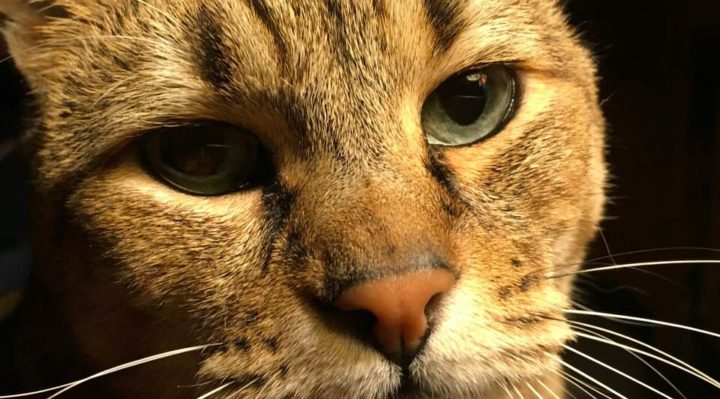
You’ve heard the horror stories, you’ve seen the online photos. Cats suffering from complications of de-clawing surgery—claw nubs growing under the skin, claw remnants poking through the skin, cats experiencing discomfort, even pain, from botched de-claw surgeries.
You don’t like your cat’s claws destroying your furniture, but you don’t want the cat to suffer. What can go wrong—and what can go right—in a cat de-claw?
Rita Bierley My friend’s beautiful black cat, Phoebe, had all four paws done before they adopted her. The [surgery] was blotched and Phoebe has problems with her paws now. [My friends] have to make sure they use high-quality litter and keep it very clean.
Christine Hale Vertucci I adopted an eight-year-old male orange tabby, Tiger, almost 20 years ago. He walked on-leash and had been front-paw de-clawed. He was very tolerant of handling and was great at the vet at first. Within the first year, we noticed him chewing at one of his paws and found out that one of his claws was incompletely removed and had grown back. Tiger had to have surgery again, and he was never the same with handling or visits.
Evelyn Hughes In the early 1990s, I was young and stupid and newly married. Our rescue cat, Winkie, tended to leave scratches when he jumped up to anything hard, like furniture. Because he was gouging my then-husband’s desk, he (the husband) insisted that Winkie be de-clawed. I knew nothing about clipping claws back then and would certainly have tried that before a surgical procedure. Sadly, though, we went ahead with the de-clawing. For the rest of his near-19 years, Winkie jumped gingerly, remembering the pain in his front paws just after the surgery. And also ever after—and he was a big cat in his prime—he minced when he walked. From the loss of those joints, or from recalled pain? I don’t know. I would never de-claw a cat today . . . ever.

Photo by Mary Cole
Ellen Endres Peters To help with understanding why some folks might do it . . . Decades ago (I was about 22 years old), living in San Diego, I rescued a kitten who was trembling in the parking lot at the very busy San Diego airport—moments from getting crushed by one of a zillion cars. I took her home to my apartment, where the landlord quickly told me I could only keep her if I had her de-clawed. I asked around to friends and co-workers for anyone to take her because I didn’t want to do that to her, but nobody would/could. So, reluctantly, I had it done because I was afraid of her being euthanized at the shelter (I didn’t care at all about my furniture). I never noticed any problems from it, but years later we moved to Nine Mile Falls in Washington state—from apartment living to country living—and I regretted it all the more because then we had to worry about her getting outside. I’ve had many, many cats since then, plus I’m older and wiser, and I’ve never even considered doing it again. I wouldn’t. But at the time I was young and felt I was choosing between the Devil and the deep blue sea. Also, there wasn’t the internet then where you could Google all the bad things about it, so I was uneducated on the topic to boot. I still feel awful about it.
Megan Cuilla I had de-clawed cats growing up. It was just what you did then. Veterinary medicine has come a long way very quickly.
Clea Simon Same here. We didn’t know. I feel so bad about it now and would never do it again.
“A separate study published in May of 2017 by the Journal of Feline Medical Surgery compared the behaviors, including inappropriate elimination, excessive grooming and aggression, of cats that had been de-clawed compared to cats that not been de-clawed, the de-clawed cats significantly demonstrated more of these behaviors. Sixty-three percent of the de-clawed cats were found to have bone fragments left in their digits; these cats were more likely to have back pain, inappropriate elimination, biting and aggression. De-clawed cats without retained bone fragments were found to have increased biting and inappropriate elimination.”
http://animalbehaviorist.us/StressRelatedLitterboxAversion
What are non-surgical alternatives to de-claw removal for the average cat?
Cissy Stamm Start your cat as a kitten or as young as possible getting paws clipped so that there isn’t a pointy tip. Start slowly—one nail at a time. I use regular toenail clippers.
Megan Cuilla I trim front and back about once a week. We started working with her paws as soon as we brought her home [as a kitten], so she’s used to it.
Janice Langbehn I now trim my cats with my human larger nail clippers once a week. Piece of cake. Both front and back. No problems. Been doing Bandit [since he was] seven weeks. If I forget to do it on time, he spreads out his toes and pretends to bite them. He is anything but subtle.
Here’s a short video that demonstrates how to trim a cat’s nails:
https://www.youtube.com/watch?v=3nJPB4ejnPk&feature=youtu.be
Linda Lukens For me, I provide lots of things that they can scratch on, and never buy expensive furniture. I practice acceptance that my cats will scratch my furniture, and it’s okay.
Leanne Hugg I had good luck with the soft caps for my guy as a kitten. He liked the corrugated cardboard scratchers best. Super tall cat trees helped; short scratching posts that didn’t allow them to fully stretch were not [helpful]. All of my cats were good about nail trims. It took my newest guy a little bit to get comfortable with it but he’s getting there.
Micha Michlewicz Nail caps, nail trimming (scratching posts, scratch-board training, Dremel, clipping) . . .
Stephanie Sublie Ullah I use a [product that smells] and essential oils as deterrents. Also, everyone is always, like, “You have blankets on your couches all the time.” Yes, because I have kids that are messy and so the cats can’t scratch the couches.
What about those situations where it really is a matter of no claws or no cat?
Consider all the possible alternatives and, if a de-claw is the only realistic choice for your cat, search out a veterinarian who’s experienced in doing de-claw surgeries well.
Ruth L. Heller DVM I don’t like de-clawing. None of my cats are de-clawed, and won’t ever be, unless I adopt them already done. That said, I do de-claw cats in my practice, and I am very, very good at it, because when I decided that I would continue to do it, I also decided that I would do it only if I could do it properly.
Why did I decide I would do it? Because the choice between a cat with all its claws and no home and a de-clawed cat with a home is a pretty easy one for me to make. When an owner looks at me in all seriousness and says, “I cannot keep him if he has his claws,” that is not something I am going to change, despite all efforts at education. Or an owner on blood thinners and a cat who is quick with his claws? Not a good match-up.
I have recommended de-clawing two cats. One had nail-bed infections we could not get to clear up, and the other was a cat who was so stressed about nail trims that I actually feared for his heart doing them.
But you asked about horror stories, not the reasons why de-clawing continues to be done.
I have seen several cats with ongoing foot pain (none of them were cats I had done the surgery on) and bone fragments present. I have seen cats with incomplete removal (again, not my patients for their surgeries) where nails grew back, usually in a deranged pattern that frequently caused pain. I have seen bleeding and pain post-op, although with current methods of pain relief and laser treatments, that is much, much reduced. (And I will not do a de-claw without free rule over pain control.)
Also, my surgical techs and I don’t talk to each other during them, because we are liable to swear. We really don’t like doing the surgery.
Over 25 years, I have seen far fewer horror stories than you might think, though, judging from this thread. The vast majority of de-clawed cats live perfectly fine lives after surgery.



